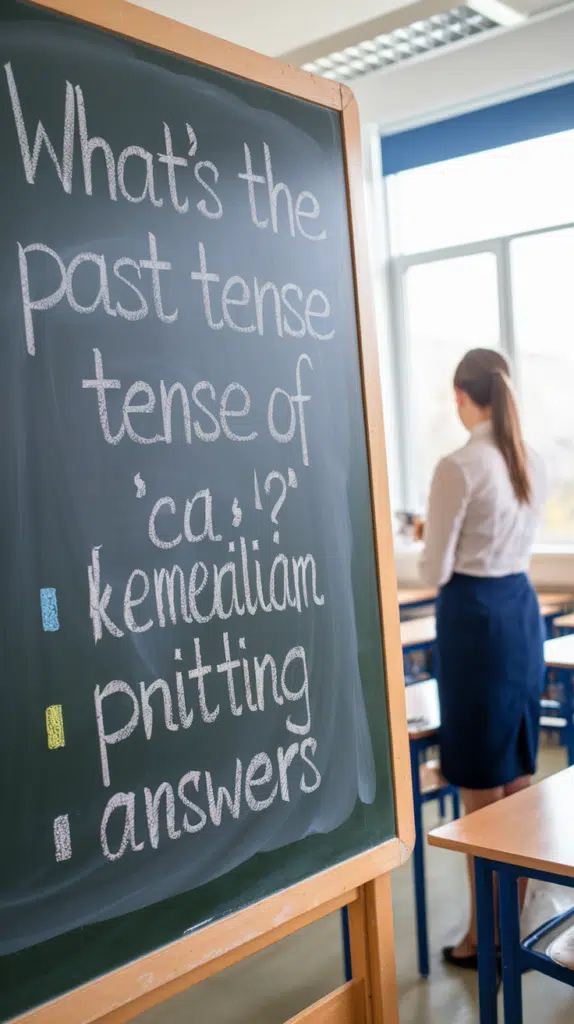What’s the Past Tense of Tear?
Ever typed a sentence and suddenly froze at the word “tear” thinking, “Is the past tense tore… or torn… or even teared?” Don’t worry this confusing verb tricks even native speakers!
Because “tear” means both to rip and to cry, each meaning uses a different past form. This guide cuts through the confusion fast, showing you exactly when to use tore, torn, and teared with examples you’ll remember instantly.
like more : Nouns That Start With A – Grammar Beacon

What Does the Word “Tear” Mean?
The Dual Nature of “Tear”
The word “tear” functions as both a verb and a noun, each with distinct meanings that can change the context in which it’s used.
As a Verb
To Rip or Pull Apart:
This meaning refers to physically damaging something by ripping it.
Example: I often tear the packaging when opening a new toy for my child.
To Cry or Shed Tears:
This usage relates to expressing emotion, often linked to sadness or joy.
Example: He teared up during the emotional farewell at the airport.
As a Noun
A Drop of Liquid from the Eye:
Here, “tear” signifies the fluid released during emotional moments.
Example: A tear slipped down her cheek as she listened to the heartfelt story.
A Rip or Laceration:
In this sense, “tear” refers to the physical damage inflicted on an object.
Example: The backpack had a tear after being dragged along the rough ground.
Understanding these definitions is crucial for grasping the nuances of the verb “tear” and its various past tense forms.
Why is There Confusion?
When grappling with the question, “What’s the past tense of tear? Is it tore, teared, or torn?” many learners find themselves puzzled. Here’s why:
Different Forms, Different Meanings
- “Tear” as in ripping something changes to “tore” in the simple past.
- “Tear” when discussing crying takes the form “teared.”
- The past participle for both meanings is “torn.”
This complexity can make it challenging to choose the correct form, but understanding the distinctions will help clarify your usage.
like more : The Past Tense of Meet – Grammar Beacon

The Past Tense of “Tear”
Let’s explore the different forms of “tear” in detail, providing context and examples for each.
1. Tear (The Present Tense)
In the present tense, “tear” indicates ongoing actions. Here are a couple of scenarios:
- Example 1: I tear the paper carefully to avoid any mess.
- Example 2: She tears up old magazines for her art project.
2. Tore (The Simple Past Tense)
The past tense “tore” is used when referring to the action of ripping something apart. Here are some illustrative examples:
- Example 1: Yesterday, I tore the letter in frustration after reading it.
- Example 2: During the craft session, the kids accidentally tore the banner.
This form clearly indicates that the action has been completed.
3. Torn (The Past Participle)
“Torn” serves as the past participle and is often used in perfect tenses. Here are examples that illustrate its use:
- Example 1: The dress has been torn at the seams after the party.
- Example 2: They found the report had been torn apart, making it unreadable.
Using “torn” emphasizes a state that results from a past action.
4. Teared (The Past Tense of Tear for Crying or Shedding Tears)
When discussing emotional responses, “teared” is appropriate. Here’s how it can be used:
- Example 1: She teared up when she saw her childhood home for the last time.
- Example 2: After hearing the sad news, he teared unexpectedly.
In both examples, “teared” indicates a past action related to crying.
like more : the Past Tense of Swing – Grammar Beacon
Pronunciation of “Tear,” “Tore,” “Torn,” and “Teared”
Correct pronunciation aids in clear communication. Let’s break down the pronunciation of these terms:
- “Tear” (to rip) is pronounced /tɛr/.
- “Tore” is pronounced /tɔr/.
- “Torn” sounds like /tɔrn/.
- “Teared” (from crying) is pronounced /tɪrd/.
Being aware of these nuances will enhance your spoken English skills.
A Simple Table Showing the Present, Past, and Future Tense of the Verb “Tear”
For quick reference, here’s a concise table summarizing the verb forms related to “tear.”
| Tense | Verb Form |
| Present | Tear |
| Simple Past | Tore |
| Past Participle | Torn |
| Past Tense (crying) | Teared |
This table serves as a helpful guide for using “tear” in different contexts.

Examples of “Tear,” “Tore,” “Torn,” and “Teared” in Sentences
Let’s provide more examples for clarity:
Tear (The Present Tense)
- “I tear the fabric before sewing it into a dress.”
- “They usually tear the documents into shreds before recycling.”
Tore (The Simple Past Tense)
- “He tore the map while trying to fold it back.”
- “The cat tore the curtains down during its playful antics.”
Torn (The Past Participle)
- “The rug has been torn in several places, so we need to replace it.”
- “She had never seen the picture so torn before it was restored.”
Teared (The Past Tense for Crying)
- “During the performance, he teared up, moved by the music.”
- “She teared when she heard her friend’s touching story.”
Synonyms for “Tear,” “Tore,” “Torn,” and “Teared”
Expanding your vocabulary will aid in effective communication. Here are synonyms for each form:
(Present Tense)
- Rip
- Rend
- Split
- Lacerate
(Simple Past Tense)
- Ripped
- Shredded
- Cleaved
- Separated
(Past Participle)
- Ripped
- Lacerated
- Frayed
- Shredded
for “Teared” (Past Tense for Crying)
- Wept
- Sobbed
- Shed tears
- Bawled
By incorporating these synonyms into your vocabulary, you can enhance your expressive capabilities in writing and conversation.
Origins of the Word “Tear”
The etymology of “tear” is quite interesting. It comes from the Old English word “teran,” which means to rip or tear apart. This historical background highlights the word’s long-standing significance in the English language.
The Noun “Tear” (The Fluid Drop from the Eye)
In its noun form, “tear” refers to the liquid that flows from the eyes. This use often appears in emotional contexts. For example:
- “A tear rolled down her cheek as she listened to the emotional speech.”
This example illustrates how the noun form conveys feelings of sadness or nostalgia.
The Verb “Tear” (To Rend or Pull Apart by Force)
The verb form “tear” emphasizes the act of ripping or pulling apart. Consider this scenario:
- “He had to tear the packaging open to get to the new game.”
In this context, the physical action of tearing is emphasized.
The Verb “Tear” (To Weep or Cry)
When discussing emotional reactions, “tear” becomes a powerful descriptor:
- “She couldn’t help but tear up when she saw the surprise party her friends organized.”
Here, “tear” effectively communicates an emotional response.

The Noun “Tear” (A Tearing or Laceration)
In another sense, “tear” can describe physical damage. For example:
- “The bag had a noticeable tear after the hike.”
This illustrates the tangible result of the act of tearing.
The Verb “Tear” (To Move Noisily)
Additionally, “tear” can refer to moving quickly or noisily, often with a sense of urgency. Here’s an example:
- “He tore down the street on his skateboard, eager to meet his friends.”
This usage showcases the versatility of the verb “tear.”
Common Mistakes and How to Avoid Them
When using “tear,” it’s easy to mix up the forms. Here are some common mistakes and tips on how to avoid them:
1. Mixing Up “Tore” and “Torn”
- Mistake: Saying “I have tore my shirt.”
- Correction: Use the past participle: “I have torn my shirt.”
2. Confusing “Teared”
and “Tore”
- Mistake: Saying “He teared the paper.”
- Correction: Use the correct form: “He tore the paper.”
3. Using “Teared” Incorrectly
- Mistake: Saying “She has teared up.”
- Correction: The correct form is: “She has teared up.”
Familiarizing yourself with these common errors will enhance your command of the language.
Practical Tips for Using “Tear” in Writing
To ensure proper usage of “tear” and its forms, keep these tips in mind:
Context Matters: Always consider whether you’re discussing ripping something or crying.
Know the Forms: Familiarize yourself with “tear,” “tore,” “torn,” and “teared.”
Read Widely: Engage with English literature, articles, and media to see these terms in action.
Practice Writing: Incorporate different forms of “tear” in your writing for reinforcement.
Seek Feedback: If in doubt, ask others for feedback on your usage of “tear.”

Conclusion
Understanding the past tense of “tear” doesn’t need to be confusing. Once you know the difference between tore, torn, and teared, you can express yourself with confidence whether you’re talking about ripping something apart or tearing up emotionally. Remember: ✔ Tore = past tense of ripping ✔ Torn = past participle ✔ Teared = past tense of crying
With these simple rules and examples, you’ll never hesitate again. Master these forms today, and watch your writing and your grammar confidence level up instantly!
FAQs
What is the correct past tense of “tear” when talking about ripping something?
The correct past tense is tore. Example: She tore the letter yesterday.
Is “teared” a real word?
Yes! Teared is correct only when talking about crying. Example: He teared up during the speech.
When should I use “torn”?
Use torn as the past participle, usually with has/have/had. Example: The page has been torn accidentally.
Can “tear” really have two meanings?
Yes to rip and to cry. Each meaning uses different past forms, which is why learners get confused.
Which is correct: “I have tore” or “I have torn”?
The correct form is I have torn. “Tore” is never used with “have.”
Why do people confuse tore, torn, and teared?
Because “tear” has two meanings, and most English verbs don’t split into multiple past forms. This verb is an exception.
Is “teared” used in formal English?
Yes, it is accepted, especially in the phrase “teared up.” However, some speakers prefer “she cried” instead.
What’s the easiest way to remember the difference?
Simple rule:
- Ripping = tore/torn
- Crying = teared
Sources
- Merriam-Webster Dictionary
- Oxford English Dictionary
- Cambridge Dictionary
With this expanded guide, you should now have a richer grasp of “tear” and its various forms. Happy learning!

James Logan is a seasoned blogger and language enthusiast behind Grammar Beacon. With years of experience in grammar and writing, James shares his expertise through insightful and engaging content. His passion for clear communication and linguistic precision shines in every post, making complex grammar concepts accessible and enjoyable for readers. Follow James for expert advice and tips to refine your writing skills.







